-

新人教版高中英语选修2Unit 2 Learning about Language教学设计
The activity theme of this section is to design various activities around the key words in the first text. Therefore, the activities require students to pay attention to the spelling of words. On the other hand, let students grasp the meaning of words more accurately through sentences and short texts. This kind of teaching design also helps to improve the ability of using English thinking.1. Cultivating students' ability to use word formation to induce and memorize vocabulary, and the ability to use lexical chunks to express meaning.2. Guide the students to think independently and use the correct form of words to complete sentences3. Cultivate students' habit of using lexical chunks to express language completely, guide students to draw words in sentences quickly, pay attention to word collocation, so as to accumulate more authentic expressions4. Instruct students to create sentences with the chunks.1. Enable students to use the language points in the real situation or specific contexts flexibly and appropriately.2. Guiding the Ss to use unit topic words and the sentence patterns in a richer context.Step1: Think of a word that best fits each definition.1. to remember sth2.to accept, admit, or recognize sth or the truth/existence of sth3. the process of changing sth or yourself to suit a new situation4 .to make sb feel less worried or unhappy5. a strong desire to achieve sth

新人教版高中英语选修2Unit 5 Reading for writing教学设计
你校英语报计划出版一期急救常识专刊,现面向全校学生公开征集稿件,你有意参加。请你根据下面提示内容,用英语写一篇短文,介绍在车祸现场对伤者进行急救的方法和步骤。1.确保现场的安全;2.询问伤者,确保其呼吸正常;3.检查伤口,如流血则应采取止血措施;4.如需急救,确保其处于康复位置。注意:1.词数80左右;2.可以适当增加细节,以使行文连贯。参考词汇:康复位置 recovery positionAs we all know, having a knowledge of first aid can make a great difference in our daily life. If a traffic accident happens and someone is injured, the following steps can be used to treat the injured.In the first place, we should make sure that the accident scene is safe so that we won’t get hurt. We should ask the injured person if he is OK, and see if he is breathing. What’s more, we should check for cuts and wounds. If he is bleeding badly, it is vital that we should try to stop the bleeding by applying pressure to the injury. This is because if a person loses too much blood, he may die. If necessary, take the injured person to the hospital as soon as possible.Do remember: when giving first aid, please be sure to place the person in a recovery position.

新人教版高中英语选修2Unit 2 Reading for writing教学设计
The theme of this section is to express people's views on studying abroad. With the continuous development of Chinese economic construction, especially the general improvement of people's living standards, the number of Chinese students studying abroad at their own expense is on the rise. Many students and parents turn their attention to the world and regard studying abroad as an effective way to improve their quality, broaden their horizons and master the world's advanced scientific knowledge, which is very important for the fever of going abroad. Studying abroad is also an important decision made by a family for their children. Therefore, it is of great social significance to discuss this issue. The theme of this section is the column discussion in the newspaper: the advantages and disadvantages of studying abroad. The discourse is about two parents' contribution letters on this issue. They respectively express their own positions. One thinks that the disadvantages outweigh the advantages, and the other thinks that the advantages outweigh the disadvantages. The two parents' arguments are well founded and logical. It is worth noting that the two authors do not express their views on studying abroad from an individual point of view, but from a national or even global point of view. These two articles have the characteristics of both letters and argumentative essays1.Guide the students to read these two articles, and understand the author's point of view and argument ideas2.Help the students to summarize the structure and writing methods of argumentative writing, and guides students to correctly understand the advantages and disadvantages of studying abroad3.Cultivate students' ability to analyze problems objectively, comprehensively and deeply

新人教版高中英语选修2Unit 2 Using langauge-Listening教学设计
? B: Absolutely! Getting involved with Chinese cultural activities there definitely helped a lot. I got to practice my Chinese on a daily basis, and I could learn how native Chinese speakers spoke.? A: What do you feel is your biggest achievement?? B: Learning Chinese characters! I have learnt about 1,500 so far. When I first started, I didn't think it was even going to be possible to learn so many, but now I find that I can read signs, menus, and even some easy newspaper articles.? A: What are you most keen on?? B: I've really become keen on learning more about the Chinese culture, in particular Chinese calligraphy. As I have learnt Chinese characters, I have developed a great appreciation for their meaning. I want to explore Chinese characters by learning how to write them in a more beautiful way. ? A: Finally, what do you want to say to anyone interested in learning Chinese?? I have really become keen on learning more about the Chinese culture, in particular Chinese Calligraphy. As I have learnt Chinese character, I have developed a great appreciation for their meaning. I want to explore Chinese characters by learning how to write them in a more beautiful way.? A: Finally, what do you want to say to anyone interested in learning Chinese?? B: I'd say, give it a shot! While some aspects may be difficult, it is quite rewarding and you will be happy that you tried.? A: Thanks for your time. ? B:You're welcome.

新人教版高中英语选修2Unit 4 Learning about Language教学设计
This section guides students to pay attention to the typical context of vocabulary use, helps students accumulate vocabulary around the key vocabulary of this unit, and uses the learned words and word chunks in different contexts to deeply understand their meaning and usage, so as to achieve the purpose of review and consolidation.The teaching design activities aim to guide students to pay attention to the typical context in which the target vocabulary is used, as well as the common vocabulary used in collocation, so that students can complete the sentence with correct words. In terms of vocabulary learning strategies, this unit focuses on cultivating students' ability to pay attention to collocation of words and to use word blocks to express meaning.For vocabulary learning, it is not enough just to know the meaning of a single word, but the most important thing is to master the common collocations of words, namely word blocks.Teachers should timely guide students to summarize common vocabulary collocation, such as verb and noun collocation, verb and preposition collocation, preposition and noun collocation, and so on.1. Guide students to understand and consolidate the meaning and usage of the vocabulary in the context, 2. Guide the students to use the unit topic vocabulary in a richer context3. Let the students sort out and accumulate the accumulated vocabulary, establishes the semantic connection between the vocabulary,4. Enable students to understand and master the vocabulary more effectivelyGuiding the Ss to use unit topic words and the sentence patterns in a richer context.

新人教版高中英语选修2Unit 4 Reading for writing教学设计
假定你是英国的Jack,打算来中国旅行,请你给你的中国笔友李华写一封信,要点如下:1.你的旅行计划:北京→泰山→杭州;2.征求建议并询问他是否愿意充当你的导游。注意:1.词数80左右(开头和结尾已给出,不计入总词数);2.可以适当增加细节,以使行文连贯。参考词汇:故宫 the Forbidden City;泰山 Mount TaiDear Li Hua,I'm glad to tell you that 'm going to visit China.First,I am planning to visit Beijing,the capitalof China,where I am looking forward to enjoying the Great Wall,the Forbidden City and somebeautiful parks.Then I intend to go to visit Mount Tai in Shandong Province.I've heard that it is one ofthe most famous mountains in China and I can't wait to enjoy the amazing sunrise there.After that,I amalso going to Hangzhou.It is said that it is a beautiful modern city with breathtaking natural sights,among which the West Lake is a well- known tourist attraction.What do you think of my travel plan? Will you act as my guide? Hope to hear from you soon.

新人教版高中英语选修2Unit 5 Reading and thinking教学设计
The theme of this activity is to learn the first aid knowledge of burns. Burns is common in life, but there are some misunderstandings in manual treatment. This activity provides students with correct first aid methods, so as not to take them for granted in an emergency. This section guides students to analyze the causes of scald and help students avoid such things. From the perspective of text structure and collaborative features, the text is expository. Expository, with explanation as the main way of expression, transmits knowledge and information to readers by analyzing concepts and elaborating examples. This text arranges the information in logical order, clearly presents three parts of the content through the subtitle, accurately describes the causes, types, characteristics and first aid measures of burns, and some paragraphs use topic sentences to summarize the main idea, and the level is very clear.1. Guide students to understand the causes, types, characteristics and first aid methods of burns, through reading2. Enhance students’ ability to deal withburnss and their awareness of burns prevention3. Enable students to improve the ability to judge the types of texts accurately and to master the characteristics and writing techniques of expository texts.Guide students to understand the causes, types, characteristics and first aid methods of burns, through readingStep1: Lead in by discussing the related topic:1. What first-aid techniques do you know of ?CPR; mouth to mouth artificial respiration; the Heimlich Manoeuvre

新人教版高中英语选修2Unit 5 Using langauge-Listening教学设计
The theme of this section is to learn how to make emergency calls. Students should learn how to make emergency calls not only in China, but also in foreign countries in English, so that they can be prepared for future situations outside the home.The emergency telephone number is a vital hotline, which should be the most clear, rapid and effective communication with the acute operator.This section helps students to understand the emergency calls in some countries and the precautions for making emergency calls. Through the study of this section, students can accumulate common expressions and sentence patterns in this context. 1.Help students accumulate emergency telephone numbers in different countries and learn more about first aid2.Guide the students to understand the contents and instructions of the telephone, grasp the characteristics of the emergency telephone and the requirements of the emergency telephone.3.Guide students to understand the first aid instructions of the operators.4.Enable Ss to make simulated emergency calls with their partners in the language they have learned1. Instruct students to grasp the key information and important details of the dialogue.2. Instruct students to conduct a similar talk on the relevant topic.Step1:Look and discuss:Match the pictures below to the medical emergencies, and then discuss the questions in groups.

新人教版高中英语选修2Unit 5 Learning about Language教学设计
The purpose of this section of vocabulary exercises is to consolidate the key words in the first part of the reading text, let the students write the words according to the English definition, and focus on the detection of the meaning and spelling of the new words. The teaching design includes use English definition to explain words, which is conducive to improving students' interest in vocabulary learning, cultivating their sense of English language and thinking in English, and making students willing to use this method to better grasp the meaning of words, expand their vocabulary, and improve their ability of vocabulary application. Besides, the design offers more context including sentences and short passage for students to practice words flexibly.1. Guide students to understand and consolidate the meaning and usage of the vocabulary in the context, 2. Guide the students to use the unit topic vocabulary in a richer context3. Let the students sort out and accumulate the accumulated vocabulary, establishes the semantic connection between the vocabulary,4. Enable students to understand and master the vocabulary more effectivelyGuiding the Ss to use unit topic words and the sentence patterns in a richer context.Step1: Read the passage about chemical burns and fill in the blanks with the correct forms of the words in the box.
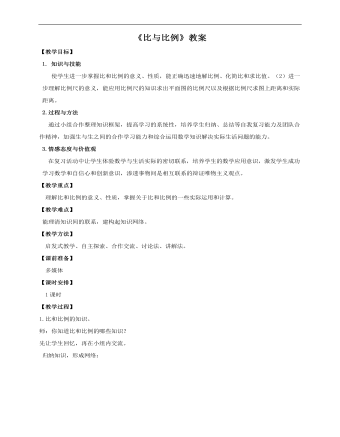
小学数学人教版六年级下册《第四课比与比例》教案说课稿
2.过程与方法 通过小组合作整理知识框架,提高学习的系统性,培养学生归纳、总结等自我复习能力及团队合作精神,加强生与生之间的合作学习能力和综合运用数学知识解决实际生活问题的能力。3.情感态度与价值观在复习活动中让学生体验数学与生活实际的密切联系,培养学生的数学应用意识,激发学生成功学习数学和自信心和创新意识,渗透事物间是相互联系的辩证唯物主义观点。【教学重点】 理解比和比例的意义、性质,掌握关于比和比例的一些实际运用和计算。【教学难点】能理清知识间的联系,建构起知识网络。【教学方法】启发式教学、自主探索、合作交流、讨论法、讲解法。【课前准备】
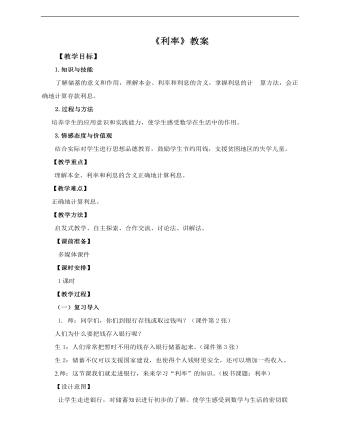
小学数学人教版六年级下册《第四课利率》教案说课稿
2.过程与方法 培养学生的应用意识和实践能力,使学生感受数学在生活中的作用。3.情感态度与价值观结合实际对学生进行思想品德教育,鼓励学生节约用钱,支援贫困地区的失学儿童。 【教学重点】 理解本金、利率和利息的含义正确地计算利息。 【教学难点】 正确地计算利息。【教学方法】启发式教学、自主探索、合作交流、讨论法、讲解法。【课前准备】 多媒体课件【课时安排】 1课时【教学过程】(一)复习导入 1. 师:同学们,你们到银行存钱或取过钱吗?(课件第2张)人们为什么要把钱存入银行呢?生1:人们常常把暂时不用的钱存入银行储蓄起来。(课件第3张)生2:储蓄不仅可以支援国家建设,也使得个人钱财更安全,还可以增加一些收入。2.师:这节课我们就走进银行,来来学习“利率”的知识。(板书课题:利率)
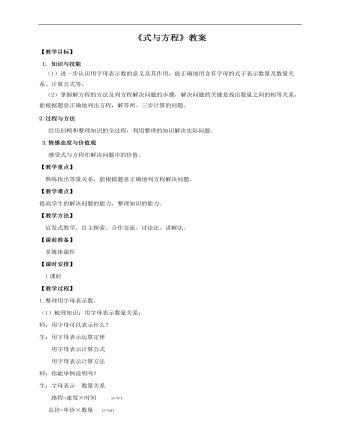
小学数学人教版六年级下册《第三课式与方程》教案说课稿
1.整理用字母表示数。(1)梳理知识:用字母表示数量关系:师:用字母可以表示什么?生:用字母表示运算定律用字母表示计算公式用字母表示计算方法师:你能举例说明吗?生:字母表示 数量关系路程=速度×时间 s=vt总价=单价×数量 c=an工作总量=工作效率×工作时间 c=at(2)字母表示计算方法:+=(3)用字母表示计算公式。师:用字母可以表示哪些平面图形的计算公式生:长方形 周长 c=(a+b) ×2 面积:s=ab 正方形 周长 c=4a 面积:s=a2 平行四边形 面积 s =ah三角形 面积 s=ah¸2 梯形 面积 s=(a+b)·h¸2 圆 周长c=πd=2πr 面积 s=πr2(4)用字母表示运算定律加法交换律 a+b=b+a 加法结合律 (a+b)+c=a+(b+c)乘法交换律 a×b=b×a乘法结合律 (a×b)×c=a×(b×c)乘法分配律 (a+b)×c=a×c+b×c2.在一个含有字母的式子里,数与字母、字母与字母相乘,书写时应注意的问题。师:在一个含有字母的式子里,数与字母、字母与字母相乘,书写时应注意什么?生交流:(1)在含有字母的式子里,数和字母中间的乘号可以用“?”代替,也可以省略不写。(2)省略乘号时,应当把数写在字母的前面。(3)数与数之间的乘号不能省略。加号、减号、除号都不能省略。3. 典题训练(1)填一填。①李奶奶家本月用电a千瓦时,比上个月多用10千瓦时,上个月用电( )千瓦时。②如果每千瓦时电的价格是c元,李奶奶家本月的电费是( )元。李奶奶家银行缴费卡上原有215元,扣除本月电费后,还剩( )元。③小明今年m 岁,妈妈的岁数比她的3倍少6岁。妈妈的岁数是( )岁。如果m=12,妈妈今年是( )岁。④三个连续的自然数,最大的一个是n,那么最小的一个数是( )。(2)连 一 连。比a多3的数 a3比a少3的数 3a3个a相加的和 a+33个a相乘的积 a-3a的3倍 a的
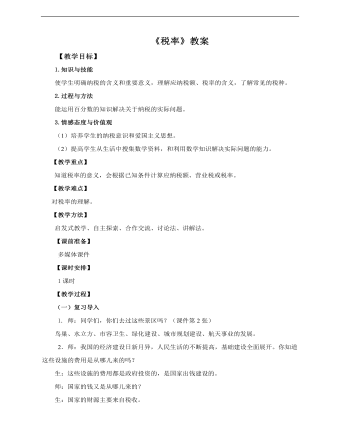
小学数学人教版六年级下册《第三课税率》教案说课稿
(一)复习导入 1. 师:同学们,你们去过这些景区吗?(课件第2张)鸟巢、水立方、市容卫生、绿化建设、城市规划建设、航天事业的发展。 2.师:我国的经济建设日新月异,人民生活的不断提高,基础建设全面展开。你知道这些设施的费用是从哪儿来的吗?生:这些设施的费用都是政府投资的,是国家出钱建设的。师:国家的钱又是从哪儿来的?生:国家的财源主要来自税收。3.导出纳税、税率。(课件第3张)生1:纳税是根据国家税法的有关规定,按照一定的比率把集体或个人收入的一部分缴纳给国家。生2:税收是国家收入的主要来源之一。国家用收来的税款发展经济、科技、教育、文化和国防等事业。生3:每个公民都有依法纳税的义务哦!这节课我们就来学习有关税收的知识。板书课题:税率【设计意图】 联系学生的生活实际,使学生知道每个公民都有依法纳税的义务,增强学生的纳税意识。(二)探究新知 1、探究税率的含义。(课件第4张)(1)你知道哪些纳税项目?应该怎样缴纳税款呢?生1:税收主要分为消费税、增值税、营业税和个人所得税等几类。生2:缴纳的税款叫做应纳税额,应纳税额与各种收入(销售额、营业额……)的比率叫做税率。2、探索应纳税额的计算。(课件第5张)(1)有一家饭店10月份的营业额是30万元,如果按营业额的5%缴纳营业税,这家饭店10月份应缴纳营业税多少万元?(2)小组讨论:你是怎样想的?说说你的思考过程。(3)汇报交流:(课件第6张)生1:缴纳的营业税是营业额的5%。生2:求营业额的5%是多少,用乘法计算。生3:30×5%=1.5(万元)答:这家饭店10月份应缴纳营业税1.5万元。3、做一做。(课件第7张)(1)李阿姨的月工资是5000元,扣除3500元个税免征额后的部分需要按3%的税率缴纳个人所得税。她应缴个人所得税多少元?小组合作:你会做吗?说说你的想法。汇报交流:(课件第8张)生1:“扣除3500元个税免征额后的部分”这句话是什么意思?生2:要从工资总数里减去3500元,剩下的钱按3%的税率缴税。生3:(5000-3500)×3%=1500×0.03=45(元)答:她应缴个人所得税45元。 (2)计算某商场5月份商品零售营业税。(课件第9张) 你会做吗?说说你的想法。小组合作:你是怎样想的?说说你的思考过程。(课件第10张)汇报交流:(课件第11张)生:先求总营业额,再求营业税。 72+35+46+21+56=230(万元)230×5%=1.15(万元) 答:这个商场5月份商品零售营业税是1.15万元。 (3)丰华商场9月份按规定缴了1.85万元的营业税,他们纳税的税率是5%。这个商场9月份的营业额是多少万元?(课件第12张)生1:把营业额看做单位“1”,求营业额,做除法。生2:1.85÷5%=1.85÷0.05=370(万元)答:这个商场9月份的营业额是370万元。生3:把营业额看做单位“1”,求营业额,也可以列方程解答。(课件第13张)解:设这个商场9月份的营业额是x万元。
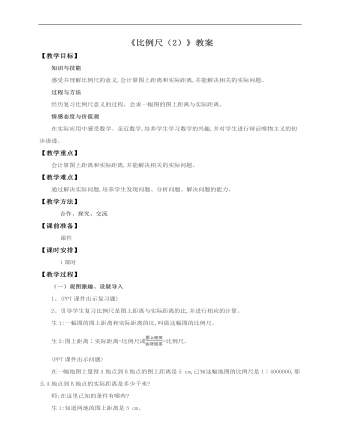
小学数学人教版六年级下册《第一课比例尺(2)》教案说课稿
(一)观图激趣、设疑导入 1、(PPT课件出示复习题)2、引导学生复习比例尺是图上距离与实际距离的比,并进行相应的计算。生1:一幅图的图上距离和实际距离的比,叫做这幅图的比例尺。生2:图上距离∶实际距离=比例尺或=比例尺。(PPT课件出示问题)在一幅地图上量得A地点到B地点的图上距离是5 cm,已知这幅地图的比例尺是1∶4000000,那么A地点到B地点的实际距离是多少千米?师:在这里已知的条件有哪些?生1:知道两地的图上距离是5 cm。生2:知道比例尺是1∶4000000。师:要解决的问题是什么?生:计算两地的实际距离是多少千米。师:这节课我们就接着来学习比例尺的应用,学习如何利用比例尺来解决实际问题,也就是已知比例尺和图上距离,求实际距离。(板书课题)【设计意图】通过把复习题中的习题变换已知和未知条件来变成本节课要解决的问题,使学生产生浓厚的兴趣,并且,也有助于培养学生举一反三、触类旁通的能力,使学生认识到数学知识的灵活性。(二)探究新知探究学习例2,已知比例尺和图上距离,求实际距离。1、PPT课件出示P54例3。下面是北京轨道交通路线示意图。地铁1号线从苹果园站至四惠东站在图中的长度大约是7.8 cm,从苹果园站至四惠东站的实际长度大约是多少千米?2、引导学生分析探究:师:从例题中可以知道哪些已知条件?生:可以知道两站的图上距离大约是7.8cm。师:这是从题目中直接读出来的,那么从所给的图中还能观察到什么条件呢?生:可以知道比例尺是1∶400000。布置学生小组讨论怎么样解决问题。学生以小组为单位进行合作学习,教师进行指导。3、汇报学习成果,师生共同探究:师:你们是怎么解答的?生1:通过列方程来解答的。生2:根据题意,可以先设实际长度为x cm,再根据“图上距离∶实际距离=比例尺”,列方程解答。师:解答时要注意什么?生1:要求实际距离是多少千米,但已知的图上距离是多少厘米,可以先设实际距离为x cm,算出实际距离的厘米数后,再化成千米数。生2:根据“图上距离∶实际距离=比例尺”,可以用解比例的方法求出实际距离。4、完成解答:(板书解题过程)图上距离:实际距离=比例尺解:设从苹果园站到四惠东站的实际长度是x cm。=x=7.8×400000x=31200003120000 cm=31.2 km答:从苹果园站到四惠东站的实际长度大约是31.2 km。5、拓展延伸:师:我们除了用方程解答之外,还可以用什么方法解答?生:可以用算术方法解答。师:可以怎样来分析呢?生:在“图上距离∶实际距离=比例尺”中,实际距离既可看成分数的分母,又可看成除法中的除数,所以可得出实际距离=图上距离÷比例尺。师:我们来共同完成解答:(板书过程)图上距离:比例尺=实际距离7.8÷=3120000(cm)3120000 cm=31.2 km答:从苹果园站到四惠东站的实际长度大约是31.2 km。6、牛刀小试。(1)师:我们一起来做两个练习题,看我们对新知识的掌握程度如何。(PPT课件出示)①教材P54做一做。先把教材P54做一做的图中的线段比例尺改写成数值比例尺,再用直尺量出图中河西村与汽车站之间的距离是多少厘米,并计算出两地的实际距离大约是多少。
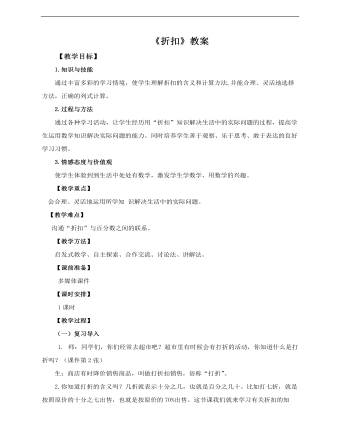
小学数学人教版六年级下册《第一课折扣》教案说课稿
(一)复习导入 1. 师:同学们,你们经常去超市吧?超市里有时候会有打折的活动,你知道什么是打折吗?(课件第2张)生:商店有时降价销售商品,叫做打折扣销售,俗称“打折”。2.你知道打折的含义吗?几折就表示十分之几,也就是百分之几十。比如打七折,就是按照原价的十分之七出售,也就是按原价的70%出售。这节课我们就来学习有关折扣的知识。(课件第3张)【设计意图】联系学生的生活实际引入课题,引起学生学习兴趣,使学生体会到生活中处处有数学。(二)探究新知 1、探究折扣的含义,计算打折后的价钱。(课件第3张)(1)星期天,小雨和爸爸来到商场买东西,正好赶上打折活动。小雨问爸爸:什么叫做“八五折”?你能回答小雨的问题吗?生1:“八五折”就是按原价的85%出售。你知道“九折”是多少吗?生2:“九折”就是按原价的90%出售。(2)爸爸给小雨买了一辆自行车,原价180元,现在商店打八五折出售。买这辆车用了多少钱?你会列式吗?(课件第4张)小组合作:你是怎样想的?说说你的思考过程。(课件第5张)(3)汇报交流:生1:把原价看做单位“1”,打八五折就是按原价的85%出售。(课件第6张)生2:现价=原价×折扣,求现价,做乘法。生3:180×85%=153(元)答:买这辆车用了153元。2、探究计算打折后便宜了多少钱的方法。爸爸买了一个随身听,原价160元,现在只花了九折的钱,比原价便宜了多少元?(课件第7张)(1)小组讨论:先求什么?再求什么?说说你的思考过程。生1:我先求现价是多少,再求比原价便宜了多少元。(课件第8张)列式为:160×90%=144(元)160-144=16(元)答:比原价便宜了16元。生2:我先求现价比原价便宜了百分之几,再求比原价便宜了多少元。(课件第9张)列式为:160×(1-90%)=160×10%=16(元)
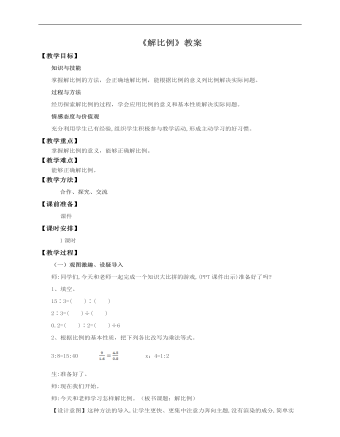
小学数学人教版六年级下册《第三课解比例》教案说课稿
(一)观图激趣、设疑导入 师:同学们,今天和老师一起完成一个知识大比拼的游戏,(PPT课件出示)准备好了吗?1、填空。15∶3=( )∶( )2∶3=( )÷( )0.2=( )∶2=( )÷62、根据比例的基本性质,把下列各比改写为乘法等式。3:8=15:40 x:4=1:2生:准备好了。师:现在我们开始。师:今天和老师学习怎样解比例。(板书课题:解比例)【设计意图】这种方法的导入,让学生更快、更集中注意力奔向主题,没有渲染的成分,简单实用。(二)探究新知1、自学解比例的意义师:阅读教材第42页,理解什么叫做解比例。生:求比例中的未知项叫做解比例。教师板书:求比例中的未知项叫做解比例。2、学习例2,应用比例的基本性质解比例。(1)出示例2的PPT课件。法国巴黎的埃菲尔铁塔高度约320 m。北京的世界公园里有一座埃菲尔铁塔的模型,它的高度与原塔高度的比是1∶10。这座模型高多少米?(2)理解题意,弄清模型的高度∶原塔高度=1∶10。师:同学们,你是怎样理解题目中1∶10的?生:题目中告诉我们1∶10是埃菲尔铁塔模型的高度与原塔高度的比。师:你能根据题意写出比例关系式吗?生:根据题意列比例关系式:模型的高度∶原塔高度=1∶10。师:这个关系式用数字该怎样表示?生:老师,在这个比例中我只知道三个数字,模型的高度的数量我不知道是几呀?师:这位同学观察得很仔细,哪位同学愿意帮助他解决这个问题?生:老师我想用字母x代替模型高度的数量,您看可以吗?师:好的,你的想法非常的好,也很正确!师:题目中告诉我们原塔高度是多少?生:320 m。
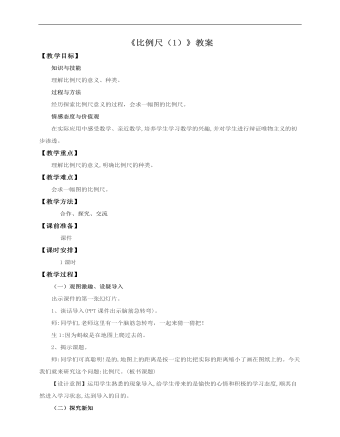
小学数学人教版六年级下册《第一课比例尺(1)》教案说课稿
(一)观图激趣、设疑导入 出示课件的第一张幻灯片。1、谈话导入(PPT课件出示脑筋急转弯)。师:同学们,老师这里有一个脑筋急转弯,一起来猜一猜把!生1:因为蚂蚁是在地图上爬过去的。2、揭示课题。师:同学们可真聪明!是的,地图上的距离是按一定的比把实际的距离缩小了画在图纸上的。今天我们就来研究这个问题:比例尺。(板书课题)【设计意图】运用学生熟悉的现象导入,给学生带来的是愉快的心情和积极的学习态度,顺其自然进入学习状态,达到导入的目的。(二)探究新知教学比例尺的意义及种类,理解比例尺的含义以及关系式。1、阅读教材第53页关于比例尺的内容。师:阅读教材后,汇报你知道了哪些关于比例尺的知识。生1:通过阅读我知道:一幅图的图上距离和实际距离的比,叫做这幅图的比例尺。图上距离∶实际距离=比例尺。(板书比例尺的意义)=比例尺生2:比例尺是绘图时用的,它是把实际距离按一定的比缩小或扩大,再画在图纸上。生3:教材介绍说,地图上的比例尺有1∶100000000,这是数值比例尺,它也可以写成这种形式,也叫数值比例尺。(板书)生4:老师,我看见这样表示比例尺的: 师:这叫线段比例尺。 它表示的是:图上1厘米的距离相当于地面上50 km的实际距离。(板书)生5:我会把上面的线段比例尺改成数值比例尺。图上距离∶实际距离。=1 cm∶50 km=1 cm∶5000000 cm(单位要相同)=1∶5000000(板书过程)生6:比例尺1∶5000000表示图上距离是实际距离的。实际距离是图上距离的5000000倍。
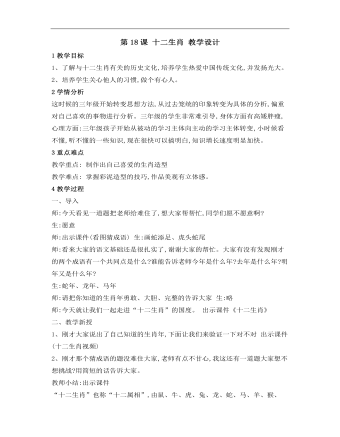
小学美术桂美版三年级上册《第18课十二生肖1》教学设计说课稿
一、导入师:今天看见一道题把老师给难住了,想大家帮帮忙,同学们愿不愿意啊?生:愿意师:出示课件(看图猜成语) 生:画蛇添足、虎头蛇尾师:看来大家的语文基础还是很扎实了,谢谢大家的帮忙。大家有没有发现刚才的两个成语有一个共同点是什么?谁能告诉老师今年是什么年?去年是什么年?明年又是什么年?生:蛇年、龙年、马年师:请把你知道的生肖年勇敢、大胆、完整的告诉大家 生:略师:今天就让我们一起走进“十二生肖”的国度。 出示课件《十二生肖》
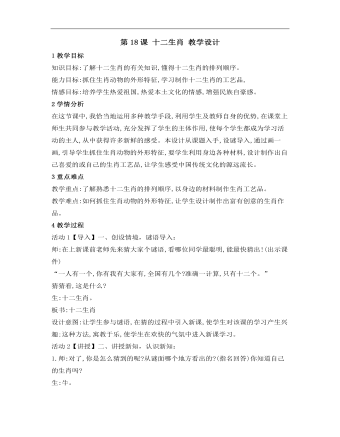
小学美术桂美版三年级上册《第18课十二生肖2》教学设计说课稿
2学情分析在这节课中,我恰当地运用多种教学手段,利用学生及教师自身的优势,在课堂上师生共同参与教学活动,充分发挥了学生的主体作用,使每个学生都成为学习活动的主人,从中获得许多新鲜的感受。本设计从课题入手,设谜导入,通过画一画,引导学生抓住生肖动物的外形特征,要学生利用身边各种材料,设计制作出自己喜爱的或自己的生肖工艺品,让学生感受中国传统文化的源远流长。
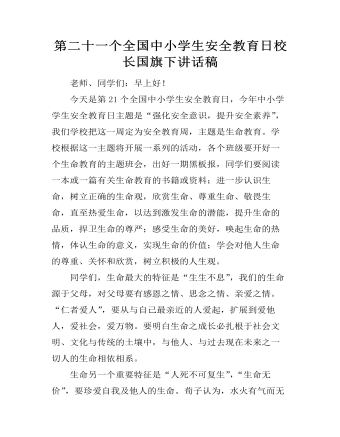
第二十一个全国中小学生安全教育日校长国旗下讲话稿
老师、同学们:早上好!今天是第21个全国中小学生安全教育日,今年中小学学生安全教育日主题是“强化安全意识,提升安全素养”,我们学校把这一周定为安全教育周,主题是生命教育。学校根据这一主题将开展一系列的活动,各个班级要开好一个生命教育的主题班会,出好一期黑板报,同学们要阅读一本或一篇有关生命教育的书籍或资料;进一步认识生命,树立正确的生命观,欣赏生命、尊重生命、敬畏生命,直至热爱生命,以达到激发生命的潜能,提升生命的品质,捍卫生命的尊严;感受生命的美好,唤起生命的热情,体认生命的意义,实现生命的价值;学会对他人生命的尊重、关怀和欣赏,树立积极的人生观。同学们,生命最大的特征是“生生不息”,我们的生命源于父母,对父母要有感恩之情、思念之情、亲爱之情。“仁者爱人”,要从与自己最亲近的人爱起,扩展到爱他人,爱社会,爱万物。要明白生命之成长必扎根于社会文明、文化与传统的土壤中,与他人、与过去现在未来之一切人的生命相依相系。

